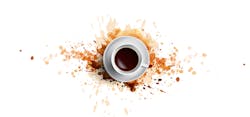Cold brew, single-serve coffee and and cannabidiol-infused products like sparkling water are among the trends that office coffee service (OCS) industry professionals pointed out prior to the U.S. outbreak of COVID19. The National Coffee Association (NCA) released its annual survey of Americans’ coffee consumption in January, before COVID-19’s disruption of the market. While the pandemic’s full impact on OCS is unknown, operators can examine the NCA’s findings on trends from earlier in 2019, revealed in The National Coffee Data Trends 2020 report.
Automatic Merchandiser provides an overview of the survey results the NCA publicly published, which included information about the coffee types different age groups prefer, the consumption of coffee products and the most popular points of sale. All of the approximately 2,850 adults who participated in the survey regularly drink beverages besides tap water, which allowed the research to focus on variations in beverage trends. This year, the NCA also compared current trends to those it saw in 2015.
Coffee preferences
About 62% of Americans, as represented by the survey group, drink coffee daily, which is a 1% drop from last year. However, coffee consumption has increased 5% since 2015. This year’s survey indicated that 70% of Americans drink coffee at least weekly, and, on average, an individual drinks a little over 3 cups daily. Young people, in comparison to 2015, are now more interested in coffee. Adults aged 18 to 24 are now 40% more likely to drink coffee, and millennials are almost 25% more likely to drink coffee than people who were 25 to 39 years old in 2015.
This year’s survey found that Americans have simplified what they add to their coffee. For instance, about 20% of Americans drink their coffee black, and from 2015 to 2020 the number of Americans who only add their preferred type of milk jumped 66%. About 4% used nut-based dairy alternatives daily, the 2020 survey found.
Trending coffee products
Cold brew, which the association remarks was “virtually unknown” in 2015, has been trending lately, with about 20% of the 18 to 39 age group (Gen Z and millennials) drinking it at least weekly. About 20% of Americans drink cold brew “regularly or occasionally.” This is consistent with last year’s survey results, which found that 20 percent of respondents regularly or occasionally drank cold brew and nearly 80% of American adults were aware of cold brew coffee.
Also of note is that this year’s survey added coconut milk and oat milk as coffee addition options, illustrating the continued increase in popularity of non-dairy, plant-based products.
Espresso-based drinks have received a 50% boost in consumption, thanks to young adults — nearly 30% of Americans under 40 prefer them. The three most popular espresso-based drinks of the past year were cappuccino (33%), latte (33%) and frozen blend (28%). There has been a 10% decrease in consumption of traditional coffee since 2015, according to the survey.
Consumption of gourmet coffee, which is brewed from premium coffee beans, has risen 25% in that time period.
Trends by age group
Different age groups have varying preferences in coffee. Millennials are more likely to enjoy frozen, blended coffee in comparison to other age groups. About half reported that they had consumed a gourmet coffee beverage in the past week, the survey found. They also steer toward straight espresso; 22% drink it at least weekly. In comparison, 43% of seniors drink at least one cup of traditional coffee per day, and only 7% of them drink espresso weekly.
They are also much less likely than young adults to consume coffee during lunch. Instead, they are more likely to drink coffee with breakfast, at about 90% consumption during that daypart, while only about 70% of Gen Z coffee consumers drink it with breakfast.
Coffee purchasing trends
OCS operators may want to prioritize providing coffee that is environmentally sustainable; the survey found that 53% of coffee drinkers want coffee that is produced with coffee farmers and the environment in mind.
Also notable is that about onefourth of Americans who ordered coffee outside the home in the past week ordered it via an app. This suggests consumers are prioritizing convenience with coffee pickup and delivery over physically entering a brick-andmortar store.
Traditional drip coffee makers have declined in popularity since 2015, with a drop of about 25%. Since 2015, about 50% more people own a singlecup brewing machine, and the same increase has been seen for daily coffee drinkers who buy coffee at a drivethrough, whether that is in a quick service restaurant, café or similar locale. That number is especially relevant during COVID-19, as some regions have limited restaurants and cafes to solely providing products via drivethrough or curbside pickup, instead of allowing customers to enter buildings. However, higher volume causes consumers to experience an increased wait time for drive-through, pickup or carry out. This provides an opportunity to operators to provide a more convenient option through OCS.
U.S. regions where coffee products thrive
Geography is another demographic factor that illustrates differences in coffee consumption. The NCA defined areas by the U.S. Census regional divisions.
The Northeast tends to see more dark roast, decaf and espresso-based beverage consumption in comparison to some other regions, while cold brew is more popular on the West Coast, which is also a leader for gourmet coffee consumption.
Understandably, Southerners are 25% more likely to desire frozen blended coffee than those who live in the Northeast. However, cold brew is about 50% more popular on the West Coast than it is in the South.
Coffee outlook
While the COVID-19 pandemic has certainly influenced OCS, Americans will surely continue to crave coffee. It will be interesting to review next year’s survey results to gain a better understanding of how COVID-19 affected U.S. coffee consumers’ preferences, especially as more Americans return to the workplace.
About the Author
Mary Stroka
Associate Editor
Mary joined the AM/VMW team in January 2019 as Associate Editor. Her love of animals extends to her snack habits, as she frequently chooses animal crackers when they are available. You can reach her via email at [email protected] or at (920) 234-8145.

